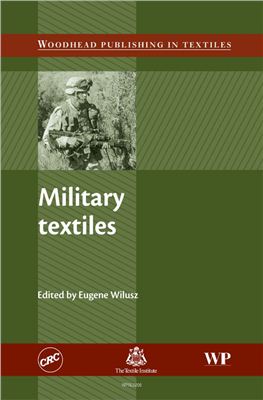Military textiles.
Edited by E Wilusz, US Army Natick Soldier Center, USA.
ISBN 1 84569 206 3.
ISBN-13: 978 1 84569 206 3.
May 2008.
384 pages.
Woodhead Publishing Series in Textiles No. 73.
- reviews the range of recent research on how military clothing can best meet soldier’s needs.
- examines damage resistance, sweat management and comfort.
- discusses the protective role of military textiles.
Textiles for military uniforms face a complex set of challenges. They must provide protection, durability and comfort in a wide range of hostile environments. Military textiles reviews the range of recent research on how military clothing can best meet soldiers’ needs.
The first part of the book reviews general requirements of military textiles, including damage resistance, comfort, sweat management, cold-weather conditions and the integration of high-tech materials into uniforms. Part II concentrates on the protective role of military textiles, covering such areas as high-performance ballistic fibres, textiles for chemical and biological protection, camouflage materials and military fabrics for flame protection. The book also reviews the use of non-woven fabrics and new coatings for military applications.
With its distinguished editor and inteational team of contributors, Military textiles is a valuable reference for those researching and manufacturing military textiles, as well as those interested in the wider area of textiles for protection.
Edited by E Wilusz, US Army Natick Soldier Center, USA.
ISBN 1 84569 206 3.
ISBN-13: 978 1 84569 206 3.
May 2008.
384 pages.
Woodhead Publishing Series in Textiles No. 73.
- reviews the range of recent research on how military clothing can best meet soldier’s needs.
- examines damage resistance, sweat management and comfort.
- discusses the protective role of military textiles.
Textiles for military uniforms face a complex set of challenges. They must provide protection, durability and comfort in a wide range of hostile environments. Military textiles reviews the range of recent research on how military clothing can best meet soldiers’ needs.
The first part of the book reviews general requirements of military textiles, including damage resistance, comfort, sweat management, cold-weather conditions and the integration of high-tech materials into uniforms. Part II concentrates on the protective role of military textiles, covering such areas as high-performance ballistic fibres, textiles for chemical and biological protection, camouflage materials and military fabrics for flame protection. The book also reviews the use of non-woven fabrics and new coatings for military applications.
With its distinguished editor and inteational team of contributors, Military textiles is a valuable reference for those researching and manufacturing military textiles, as well as those interested in the wider area of textiles for protection.

